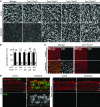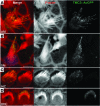Mechanotransduction in mouse inner ear hair cells requires transmembrane channel-like genes
- PMID: 22105175
- PMCID: PMC3223072
- DOI: 10.1172/JCI60405
Mechanotransduction in mouse inner ear hair cells requires transmembrane channel-like genes
Abstract
Inner ear hair cells convert the mechanical stimuli of sound, gravity, and head movement into electrical signals. This mechanotransduction process is initiated by opening of cation channels near the tips of hair cell stereocilia. Since the identity of these ion channels is unknown, and mutations in the gene encoding transmembrane channel-like 1 (TMC1) cause hearing loss without vestibular dysfunction in both mice and humans, we investigated the contribution of Tmc1 and the closely related Tmc2 to mechanotransduction in mice. We found that Tmc1 and Tmc2 were expressed in mouse vestibular and cochlear hair cells and that GFP-tagged TMC proteins localized near stereocilia tips. Tmc2 expression was transient in early postnatal mouse cochlear hair cells but persisted in vestibular hair cells. While mice with a targeted deletion of Tmc1 (Tmc1(Δ) mice) were deaf and those with a deletion of Tmc2 (Tmc2(Δ) mice) were phenotypically normal, Tmc1(Δ)Tmc2(Δ) mice had profound vestibular dysfunction, deafness, and structurally normal hair cells that lacked all mechanotransduction activity. Expression of either exogenous TMC1 or TMC2 rescued mechanotransduction in Tmc1(Δ)Tmc2(Δ) mutant hair cells. Our results indicate that TMC1 and TMC2 are necessary for hair cell mechanotransduction and may be integral components of the mechanotransduction complex. Our data also suggest that persistent TMC2 expression in vestibular hair cells may preserve vestibular function in humans with hearing loss caused by TMC1 mutations.
Figures










Comment in
-
Perception of sound and gravity by TMC1 and TMC2.J Clin Invest. 2011 Dec;121(12):4633-6. doi: 10.1172/JCI61167. Epub 2011 Nov 21. J Clin Invest. 2011. PMID: 22105165 Free PMC article.
References
Publication types
MeSH terms
Substances
Grants and funding
- R01 DC009255/DC/NIDCD NIH HHS/United States
- R01-DC009255/DC/NIDCD NIH HHS/United States
- R01-DC008853/DC/NIDCD NIH HHS/United States
- R01 DC008853/DC/NIDCD NIH HHS/United States
- R01 DC005439/DC/NIDCD NIH HHS/United States
- Z01-DC000060-10/DC/NIDCD NIH HHS/United States
- Z01-DC000021-18/DC/NIDCD NIH HHS/United States
- Z01 DC000060/ImNIH/Intramural NIH HHS/United States
- R01-DC05439/DC/NIDCD NIH HHS/United States
- R01 DC002390/DC/NIDCD NIH HHS/United States
- R01-DC002390/DC/NIDCD NIH HHS/United States
- Z01 DC000021/ImNIH/Intramural NIH HHS/United States
LinkOut - more resources
Full Text Sources
Other Literature Sources
Medical
Molecular Biology Databases

